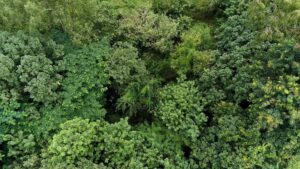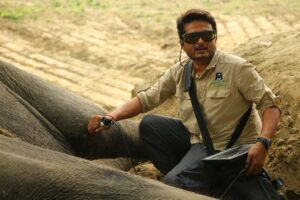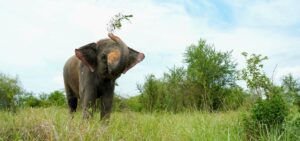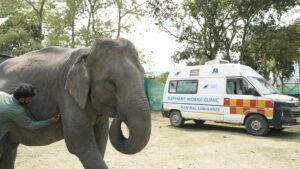The golden valleys of Kashmir are cloaked in white following winter snowfall. Children, bundled in vibrant winter clothes, run across icy paths, their laughter echoing in the crisp air. Yet, amidst this picturesque setting, a leopard moves silently through the outskirts of the village, not as a threat, but as a living being struggling to survive in its shrinking habitat.

The North Division of Kashmir borders the Line of Control (LoC) and consists of sanctuaries like Lachipora Wildlife Sanctuary that offer rich natural habitat for wildlife. However, as forests give way to expanding human settlements, leopards increasingly find themselves navigating a world where survival demands adaptation. Once confined to dense forests, these majestic predators now wander into villages in search of food. Recent months saw one such leopard frequenting a cluster of villages located in the extreme north of Kashmir, driven by a dwindling prey base and the lure of stray dogs scavenging garbage dumps.
The fragile coexistence between humans and this leopard reached its peak in early December 2024 when a series of attacks took place on unsuspecting villagers of Handwara. A young girl playing in her home’s verandah when she came in close contact with a leopard. Her screams alerted her grandmother, who rushed to her aid. The grandmother’s loud cries led to the leopard evading the scene, but the girl, however, was left with injuries.
Just days later, a young boy stepped out of his home to use an outdoor toilet when he was encountered by the same leopard. The fierce intervention of nearby villagers drove the leopard away before it could come close to the child.

In yet another encounter, a boy and his family were busy feeding their cattle during evening hours when a leopard showed up. The family’s desperate efforts to rescue the juvenile boy led to the leopard’s dismissal, but the ordeal has left them all traumatised.
The rising number of such attacks is now shattering the sense of safety among people in the village. Each encounter left scars not only on the victims and their families, but also on the psyche of the entire community. Fear spread like wildfire, and with the leopard’s presence looming large, the spaces once-familiar to humans have now transformed into terrifying territories.

Easy To Point A Finger, But Three Point Back
Voiceless wildlife, however, cannot cross question why their natural habitats are being drastically transformed. Cases of such human-wildlife conflicts are not driven by malice on the part of the leopard, but by necessity. The forests in Jammu and Kashmir that once provided abundant prey have now been fragmented, and the thin line between wilderness and human habitation has blurred. “People often forget that they are living in the forest hills,” explains Ms. Aaliya Mir, Education Officer and Programme Head at Wildlife SOS in J&K. “When habitats overlap like this, encounters are inevitable.” Of the six divisions in Jammu and Kashmir, the North Division is known for its dense forests and abundant wildlife, and is no stranger to human-wildlife interactions. However, the growing frequency of these encounters highlights a deeper, systemic issue. Wildlife corridors, essential for the seasonal movement of animals, have been increasingly disrupted by human-made infrastructure like roads, railway tracks, and the border fencing that have been installed around them. These interruptions, coupled with habitat destruction, a dwindling food supply, and reduced shelter in natural habitats, force wild animals like leopards to venture closer to human settlements.

Jammu and Kashmir’s human population is now expanding closer to protected areas. Forests and ecosystems that once lay untouched have now been transformed into agricultural fields or industrial areas to meet the growing demand for land, food, energy, and raw materials. While such invasions serve the needs of people, it leaves wildlife bereft of food and shelter. To meet their own requirements to survive, displaced leopards and other animals find themselves in proximity to people, escalating the risk of human-wildlife conflict. There certainly is an urgent need for sustainable development practices and coexistence strategies to protect humans, wildlife and nature.
Wildlife SOS’s Urgent Intervention
The above mentioned incidents led Wildlife SOS and the J&K Wildlife Protection Department to come together and curtail unexpected encounters. The two teams visited those locations to assess that particular leopard’s route, and a wholesome survey of the area was conducted to trace its movements. Pug marks and scats of the leopard were carefully analysed, and cages were strategically placed in zones having high probability of its passage. While these technical procedures were being carried out, the teams also interacted with locals and focused on what the reasons were for such episodes to recur. In-depth knowledge and field research enabled the safe capture of the concerned leopard within one of the cages that had been placed. The leopard was then transferred to the forest department in J&K’s North Division and later released into a deep forest to prevent any future conflicts.

This successful operation highlights the delicate techniques required in managing human-wildlife interactions. However, till we address the root causes of these conflicts, such solutions will only provide temporary relief.
Not monitoring garbage dumping, for instance, creates a chain reaction that ultimately attracts wildlife: stray dogs are drawn to the waste, and leopards follow the dogs as their prey. While conducting the investigation in Handwara, our team also came across an alarming amount of waste disposed within the forests that ranged from kitchen scraps and broken glass to diapers.

Another significant factor that causes frequent confrontation with wildlife is that the children from communities residing close to forests often play or move around without any adults watching over them, especially during the hours at dusk and dawn when leopards are most active. Raising awareness among locals through sensitivity and patience, especially among those that have witnessed tragic incidents of conflict, is an effort taken up by Wildlife SOS in J&K to enable coexistence between humans and wildlife. Collaborating with political and cultural leaders and local authorities is how the team disseminates advice and caution in the society, such as managing waste and keeping livestock enclosed at night.

Wildlife SOS is committed to foster coexistence with wildlife among people in Kashmir: “When a human is attacked, the emotions tend to run high. Anger leads to the leopard being blamed, but we try to shift the narrative to focus on the larger picture — how our actions impact these animals and drive them into our spaces.” By emphasizing on changes in habits such as responsible waste management, and by addressing misconceptions about leopards, awareness campaigns held aim to build a sense of empathy and understanding among locals.

The story of this leopard is not one of villainy but of survival against overwhelming odds. Its journey serves as a stark reminder of the interconnectedness of human and animal lives. As human activities continue to encroach on natural habitats, the responsibility to foster coexistence grows ever more urgent.
Click here to know more about Wildlife SOS’s wildlife conservation projects, and consider making a donation towards our efforts to mitigate human-wildlife conflict.






